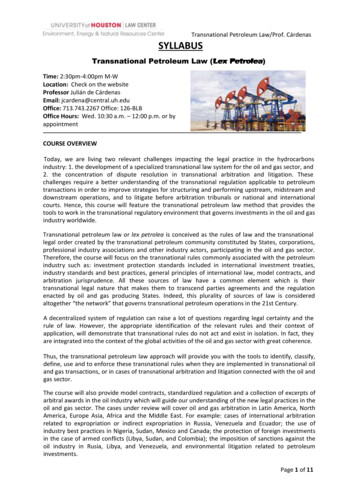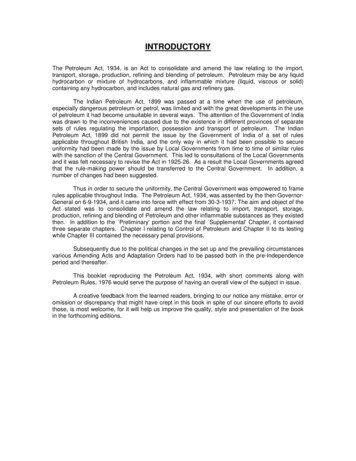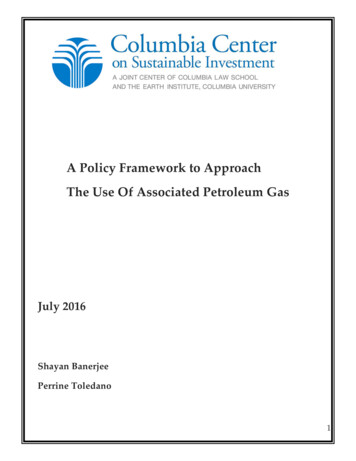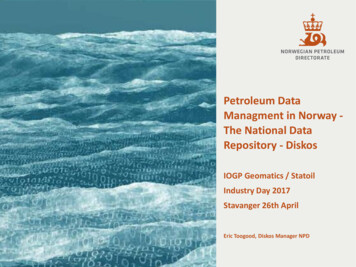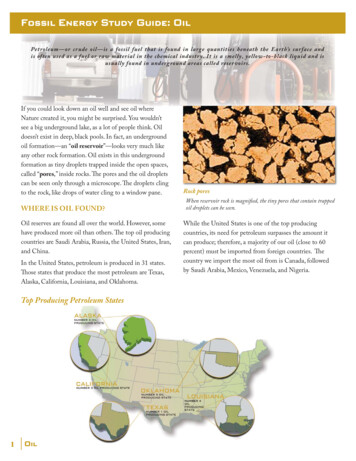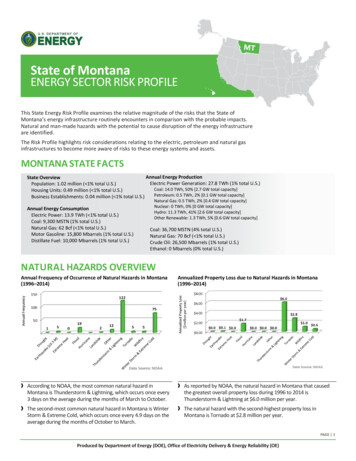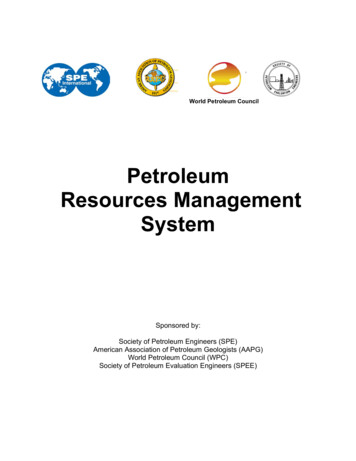
Transcription
World Petroleum CouncilPetroleumResources ManagementSystemSponsored by:Society of Petroleum Engineers (SPE)American Association of Petroleum Geologists (AAPG)World Petroleum Council (WPC)Society of Petroleum Evaluation Engineers (SPEE)
Table of ContentsPreamblePage No.11.0Basic Principles and Definitions1.1Petroleum Resources Classification Framework1.2Project-Based Resources Evaluations2242.0Classification and Categorization Guidelines2.1Resources Classification2.1.1 Determination of Discovery Status2.1.2 Determination of Commerciality2.1.3 Project Status and Commercial Risk2.1.3.1 Project Maturity Sub-Classes2.1.3.2 Reserves Status2.1.3.3 Economic Status2.2Resources Categorization2.2.1 Range of Uncertainty2.2.2 Category Definitions and Guidelines2.3Incremental Projects2.3.1 Workovers, Treatments, and Changes of Equipment2.3.2 Compression2.3.3 Infill Drilling2.3.4 Improved Recovery2.4Unconventional Resources563.04.0Evaluation and Reporting Guidelines3.1Commercial Evaluations3.1.1 Cash Flow-Based Resources Evaluations3.1.2 Economic Criteria3.1.3 Economic Limit3.2Production Measurement3.2.1 Reference Point3.2.2 Lease Fuel3.2.3 Wet or Dry Natural Gas3.2.4 Associated Non-Hydrocarbon Components3.2.5 Natural Gas Re-Injection3.2.6 Underground Natural Gas Storage3.2.7 Production Balancing3.3Resources Entitlement and Recognition3.3.1 Royalty3.3.2 Production-Sharing Contract Reserves3.3.3 Contract Extensions or RenewalsEstimating Recoverable Quantities4.1Analytical Procedures4.1.1 Analogs4.1.2 Volumetric Estimate4.1.3 Material Balance4.1.4 Production Performance Analysis4.2Deterministic and Probabilistic Methods4.2.1 Aggregation Methods4.2.1.1 Aggregating Resources Classes9111213131517191921Table 1: Recoverable Resources Classes and Sub-ClassesTable 2: Reserves Status Definitions and GuidelinesTable 3: Reserves Category Definitions and Guidelines242728Appendix A: Glossary of Terms Used in Resources Evaluations30
Note: A typographical error in this document was discovered and corrected on 7 January 2008. On Page 38 in the entryfor Liquefied Natural Gas (LNG) Project, the text previously read “LNG is about 1/164 the volume of natural gas ” Thecorrected statement is “LNG is about 1/614 the volume of natural gas ”Petroleum Resources Management SystemPreamblePetroleum resources are the estimated quantities of hydrocarbons naturally occurring on or within the Earth’scrust. Resource assessments estimate total quantities in known and yet-to-be discovered accumulations;resources evaluations are focused on those quantities that can potentially be recovered and marketed bycommercial projects. A petroleum resources management system provides a consistent approach toestimating petroleum quantities, evaluating development projects, and presenting results within acomprehensive classification framework.International efforts to standardize the definitions of petroleum resources and how they are estimated began inthe 1930s. Early guidance focused on Proved Reserves. Building on work initiated by the Society of PetroleumEvaluation Engineers (SPEE), SPE published definitions for all Reserves categories in 1987. In the same year,the World Petroleum Council (WPC, then known as the World Petroleum Congress), working independently,published Reserves definitions that were strikingly similar. In 1997, the two organizations jointly released asingle set of definitions for Reserves that could be used worldwide. In 2000, the American Association ofPetroleum Geologists (AAPG), SPE, and WPC jointly developed a classification system for all petroleumresources. This was followed by additional supporting documents: supplemental application evaluationguidelines (2001) and a glossary of terms utilized in resources definitions (2005). SPE also publishedstandards for estimating and auditing reserves information (revised 2007).These definitions and the related classification system are now in common use internationally within thepetroleum industry. They provide a measure of comparability and reduce the subjective nature of resourcesestimation. However, the technologies employed in petroleum exploration, development, production, andprocessing continue to evolve and improve. The SPE Oil and Gas Reserves Committee works closely withother organizations to maintain the definitions and issues periodic revisions to keep current with evolvingtechnologies and changing commercial opportunities.This document consolidates, builds on, and replaces guidance previously contained in the 1997 PetroleumReserves Definitions, the 2000 Petroleum Resources Classification and Definitions publications, and the 2001“Guidelines for the Evaluation of Petroleum Reserves and Resources”; the latter document remains a valuablesource of more detailed background information, and specific chapters are referenced herein. Appendix A is aconsolidated glossary of terms used in resources evaluations and replaces those published in 2005.These definitions and guidelines are designed to provide a common reference for the international petroleumindustry, including national reporting and regulatory disclosure agencies, and to support petroleum project andportfolio management requirements. They are intended to improve clarity in global communications regardingpetroleum resources. It is expected that this document will be supplemented with industry education programsand application guides addressing their implementation in a wide spectrum of technical and/or commercialsettings.It is understood that these definitions and guidelines allow flexibility for users and agencies to tailor applicationfor their particular needs; however, any modifications to the guidance contained herein should be clearlyidentified. The definitions and guidelines contained in this document must not be construed as modifying theinterpretation or application of any existing regulatory reporting requirements.This SPE/WPC/AAPG/SPEE Petroleum Resources Management System document, including its Appendix,may be referred to by the abbreviated term “SPE-PRMS” with the caveat that the full title, including clearrecognition of the co-sponsoring organizations, has been initially stated.
1.0 Basic Principles and DefinitionsThe estimation of petroleum resource quantities involves the interpretation of volumes and valuesthat have an inherent degree of uncertainty. These quantities are associated with developmentprojects at various stages of design and implementation. Use of a consistent classification systemenhances comparisons between projects, groups of projects, and total company portfoliosaccording to forecast production profiles and recoveries. Such a system must consider bothtechnical and commercial factors that impact the project’s economic feasibility, its productive life,and its related cash flows.1.1 Petroleum Resources Classification FrameworkPetroleum is defined as a naturally occurring mixture consisting of hydrocarbons in the gaseous,liquid, or solid phase. Petroleum may also contain non-hydrocarbons, common examples ofwhich are carbon dioxide, nitrogen, hydrogen sulfide and sulfur. In rare cases, non-hydrocarboncontent could be greater than 50%.The term “resources” as used herein is intended to encompass all quantities of petroleumnaturally occurring on or within the Earth’s crust, discovered and undiscovered (recoverable andunrecoverable), plus those quantities already produced. Further, it includes all types of petroleumwhether currently considered “conventional” or “unconventional.”Figure 1-1 is a graphical representation of the SPE/WPC/AAPG/SPEE resources classificationsystem. The system defines the major recoverable resources classes: Production, Reserves,Contingent Resources, and Prospective Resources, as well as Unrecoverable timateIncreasing Chance of CommercialityCOMMERCIALSUB-COMMERCIALDISCOVERED PIIPRESERVESUNRECOVERABLEUNDISCOVERED PIIPTOTAL PETROLEUM INITIALLY-IN-PLACE (PIIP)PRODUCTIONHighEstimateUNRECOVERABLERange of UncertaintyNot to scaleFigure 1-1: Resources Classification Framework.The “Range of Uncertainty” reflects a range of estimated quantities potentially recoverable froman accumulation by a project, while the vertical axis represents the “Chance of Commerciality,that is, the chance that the project that will be developed and reach commercial producing status.The following definitions apply to the major subdivisions within the resources classification:2
TOTAL PETROLEUM INITIALLY-IN-PLACE is that quantity of petroleum that is estimated toexist originally in naturally occurring accumulations. It includes that quantity of petroleum thatis estimated, as of a given date, to be contained in known accumulations prior to productionplus those estimated quantities in accumulations yet to be discovered (equivalent to “totalresources”).DISCOVERED PETROLEUM INITIALLY-IN-PLACE is that quantity of petroleum that isestimated, as of a given date, to be contained in known accumulations prior to production.PRODUCTION is the cumulative quantity of petroleum that has been recovered at agiven date. While all recoverable resources are estimated and production is measured interms of the sales product specifications, raw production (sales plus non-sales) quantitiesare also measured and required to support engineering analyses based on reservoirvoidage (see Production Measurement, section 3.2).Multiple development projects may be applied to each known accumulation, and each project willrecover an estimated portion of the initially-in-place quantities. The projects shall be subdividedinto Commercial and Sub-Commercial, with the estimated recoverable quantities being classifiedas Reserves and Contingent Resources respectively, as defined below.RESERVES are those quantities of petroleum anticipated to be commercially recoverableby application of development projects to known accumulations from a given date forwardunder defined conditions. Reserves must further satisfy four criteria: they must bediscovered, recoverable, commercial, and remaining (as of the evaluation date) based onthe development project(s) applied. Reserves are further categorized in accordance withthe level of certainty associated with the estimates and may be sub-classified based onproject maturity and/or characterized by development and production status.CONTINGENT RESOURCES are those quantities of petroleum estimated, as of a givendate, to be potentially recoverable from known accumulations, but the applied project(s)are not yet considered mature enough for commercial development due to one or morecontingencies. Contingent Resources may include, for example, projects for which thereare currently no viable markets, or where commercial recovery is dependent ontechnology under development, or where evaluation of the accumulation is insufficient toclearly assess commerciality. Contingent Resources are further categorized inaccordance with the level of certainty associated with the estimates and may be subclassified based on project maturity and/or characterized by their economic status.UNDISCOVERED PETROLEUM INITIALLY-IN-PLACE is that quantity of petroleumestimated, as of a given date, to be contained within accumulations yet to be discovered.PROSPECTIVE RESOURCES are those quantities of petroleum estimated, as of a givendate, to be potentially recoverable from undiscovered accumulations by application offuture development projects. Prospective Resources have both an associated chance ofdiscovery and a chance of development. Prospective Resources are further subdivided inaccordance with the level of certainty associated with recoverable estimates assumingtheir discovery and development and may be sub-classified based on project maturity.UNRECOVERABLE is that portion of Discovered or Undiscovered Petroleum Initially-inPlace quantities which is estimated, as of a given date, not to be recoverable by futuredevelopment projects. A portion of these quantities may become recoverable in the future ascommercial circumstances change or technological developments occur; the remainingportion may never be recovered due to physical/chemical constraints represented bysubsurface interaction of fluids and reservoir rocks.3
Estimated Ultimate Recovery (EUR) is not a resources category, but a term that may be appliedto any accumulation or group of accumulations (discovered or undiscovered) to define thosequantities of petroleum estimated, as of a given date, to be potentially recoverable under definedtechnical and commercial conditions plus those quantities already produced (total of recoverableresources).In specialized areas, such as basin potential studies, alternative terminology has been used; thetotal resources may be referred to as Total Resource Base or Hydrocarbon Endowment. Totalrecoverable or EUR may be termed Basin Potential. The sum of Reserves, ContingentResources, and Prospective Resources may be referred to as “remaining recoverableresources.” When such terms are used, it is important that each classification component of thesummation also be provided. Moreover, these quantities should not be aggregated without dueconsideration of the varying degrees of technical and commercial risk involved with theirclassification.1.2 Project-Based Resources EvaluationsThe resources evaluation process consists of identifying a recovery project, or projects,associated with a petroleum accumulation(s), estimating the quantities of Petroleum Initially-inPlace, estimating that portion of those in-place quantities that can be recovered by each project,and classifying the project(s) based on its maturity status or chance of commerciality.This concept of a project-based classification system is further clarified by examining the primarydata sources contributing to an evaluation of net recoverable resources (see Figure 1-2) that maybe described as follows:RESERVOIR(in-place cash flow)EntitlementPROPERTY(ownership/contract terms)Figure 1-2: Resources Evaluation Data Sources. The Reservoir (accumulation): Key attributes include the types and quantities of PetroleumInitially-in-Place and the fluid and rock properties that affect petroleum recovery. The Project: Each project applied to a specific reservoir development generates a uniqueproduction and cash flow schedule. The time integration of these schedules taken to theproject’s technical, economic, or contractual limit defines the estimated recoverableresources and associated future net cash flow projections for each project. The ratio of EURto Total Initially-in-Place quantities defines the ultimate recovery efficiency for thedevelopment project(s). A project may be defined at various levels and stages of maturity; itmay include one or many wells and associated production and processing facilities. Oneproject may develop many reservoirs, or many projects may be applied to one reservoir. The Property (lease or license area): Each property may have unique associated contractualrights and obligations including the fiscal terms. Such information allows definition of eachparticipant’s share of produced quantities (entitlement) and share of investments, expenses,and revenues for each recovery project and the reservoir to which it is applied. One propertymay encompass many reservoirs, or one reservoir may span several different properties. Aproperty may contain both discovered and undiscovered accumulations.4
In context of this data relationship, “project” is the primary element considered in this resourcesclassification, and net recoverable resources are the incremental quantities derived from eachproject. Project represents the link between the petroleum accumulation and the decision-makingprocess. A project may, for example, constitute the development of a single reservoir or field, oran incremental development for a producing field, or the integrated development of several fieldsand associated facilities with a common ownership. In general, an individual project will representthe level at which a decision is made whether or not to proceed (i.e., spend more money) andthere should be an associated range of estimated recoverable quantities for that project.An accumulation or potential accumulation of petroleum may be subject to several separate anddistinct projects that are at different stages of exploration or development. Thus, an accumulationmay have recoverable quantities in several resource classes simultaneously.In order to assign recoverable resources of any class, a development plan needs to be definedconsisting of one or more projects. Even for Prospective Resources, the estimates of recoverablequantities must be stated in terms of the sales products derived from a development programassuming successful discovery and commercial development. Given the major uncertaintiesinvolved at this early stage, the development program will not be of the detail expected in laterstages of maturity. In most cases, recovery efficiency may be largely based on analogousprojects. In-place quantities for which a feasible project cannot be defined using current, orreasonably forecast improvements in, technology are classified as Unrecoverable.Not all technically feasible development plans will be commercial. The commercial viability of adevelopment project is dependent on a forecast of the conditions that will exist during the timeperiod encompassed by the project’s activities (see Commercial Evaluations, section 3.1).“Conditions” include technological, economic, legal, environmental, social, and governmentalfactors. While economic factors can be summarized as forecast costs and product prices, theunderlying influences include, but are not limited to, market conditions, transportation andprocessing infrastructure, fiscal terms, and taxes.The resource quantities being estimated are those volumes producible from a project asmeasured according to delivery specifications at the point of sale or custody transfer (seeReference Point, section 3.2.1). The cumulative production from the evaluation date forward tocessation of production is the remaining recoverable quantity. The sum of the associated annualnet cash flows yields the estimated future net revenue. When the cash flows are discountedaccording to a defined discount rate and time period, the summation of the discounted cash flowsis termed net present value (NPV) of the project (see Evaluation and Reporting Guidelines,section 3.0).The supporting data, analytical processes, and assumptions used in an evaluation should bedocumented in sufficient detail to allow an independent evaluator or auditor to clearly understandthe basis for estimation and categorization of recoverable quantities and their classification.2.0 Classification and Categorization GuidelinesTo consistently characterize petroleum projects, evaluations of all resources should be conductedin the context of the full classification system as shown in Figure 1-1. These guidelines referencethis classification system and support an evaluation in which projects are “classified” based ontheir chance of commerciality (the vertical axis) and estimates of recoverable and marketablequantities associated with each project are “categorized” to reflect uncertainty (the horizontalaxis). The actual workflow of classification vs. categorization varies with individual projects and isoften an iterative analysis process leading to a final report. “Report,” as used herein, refers to thepresentation of evaluation results within the business entity conducting the assessment andshould not be construed as replacing guidelines for public disclosures under guidelinesestablished by regulatory and/or other government agencies.5
Additional background information on resources classification issues can be found in Chapter 2 ofthe 2001 SPE/WPC/AAPG publication: “Guidelines for the Evaluation of Petroleum Reserves andResources,” hereafter referred to as the “2001 Supplemental Guidelines.”2.1 Resources ClassificationThe basic classification requires establishment of criteria for a petroleum discovery and thereafterthe distinction between commercial and sub-commercial projects in known accumulations (andhence between Reserves and Contingent Resources).2.1.1 Determination of Discovery StatusA discovery is one petroleum accumulation, or several petroleum accumulations collectively, forwhich one or several exploratory wells have established through testing, sampling, and/or loggingthe existence of a significant quantity of potentially moveable hydrocarbons.In this context, “significant” implies that there is evidence of a sufficient quantity of petroleum tojustify estimating the in-place volume demonstrated by the well(s) and for evaluating the potentialfor economic recovery. Estimated recoverable quantities within such a discovered (known)accumulation(s) shall initially be classified as Contingent Resources pending definition of projectswith sufficient chance of commercial development to reclassify all, or a portion, as Reserves.Where in-place hydrocarbons are identified but are not considered currently recoverable, suchquantities may be classified as Discovered Unrecoverable, if considered appropriate for resourcemanagement purposes; a portion of these quantities may become recoverable resources in thefuture as commercial circumstances change or technological developments occur.2.1.2 Determination of CommercialityDiscovered recoverable volumes (Contingent Resources) may be considered commerciallyproducible, and thus Reserves, if the entity claiming commerciality has demonstrated firmintention to proceed with development and such intention is based upon all of the followingcriteria: Evidence to support a reasonable timetable for development.A reasonable assessment of the future economics of such development projects meetingdefined investment and operating criteria:A reasonable expectation that there will be a market for all or at least the expected salesquantities of production required to justify development.Evidence that the necessary production and transportation facilities are available or can bemade available:Evidence that legal, contractual, environmental and other social and economic concerns willallow for the actual implementation of the recovery project being evaluated.To be included in the Reserves class, a project must be sufficiently defined to establish itscommercial viability. There must be a reasonable expectation that all required internal andexternal approvals will be forthcoming, and there is evidence of firm intention to proceed withdevelopment within a reasonable time frame. A reasonable time frame for the initiation ofdevelopment depends on the specific circumstances and varies according to the scope of theproject. While 5 years is recommended as a benchmark, a longer time frame could be appliedwhere, for example, development of economic projects are deferred at the option of the producerfor, among other things, market-related reasons, or to meet contractual or strategic objectives. Inall cases, the justification for classification as Reserves should be clearly documented.To be included in the Reserves class, there must be a high confidence in the commercialproducibility of the reservoir as supported by actual production or formation tests. In certaincases, Reserves may be assigned on the basis of well logs and/or core analysis that indicate that6
the subject reservoir is hydrocarbon-bearing and is analogous to reservoirs in the same area thatare producing or have demonstrated the ability to produce on formation tests.2.1.3Project Status and Commercial RiskEvaluators have the option to establish a more detailed resources classification reporting systemthat can also provide the basis for portfolio management by subdividing the chance ofcommerciality axis according to project maturity. Such sub-classes may be characterized bystandard project maturity level descriptions (qualitative) and/or by their associated chance ofreaching producing status (quantitative).As a project moves to a higher level of maturity, there will be an increasing chance that theaccumulation will be commercially developed. For Contingent and Prospective Resources, thiscan further be expressed as a quantitative chance estimate that incorporates two key underlyingrisk components: The chance that the potential accumulation will result in the discovery of petroleum. This isreferred to as the “chance of discovery.”Once discovered, the chance that the accumulation will be commercially developed isreferred to as the “chance of development.”Thus, for an undiscovered accumulation, the “chance of commerciality” is the product of thesetwo risk components. For a discovered accumulation where the “chance of discovery” is 100%,the “chance of commerciality” becomes equivalent to the “chance of development.”2.1.3.1 Project Maturity Sub-ClassesAs illustrated in Figure 2-1, development projects (and their associated recoverable quantities)may be sub-classified according to project maturity levels and the associated actions (businessdecisions) required to move a project toward commercial production.PRODUCTIONProject MaturitySub-classesApproved forDevelopmentJustified forDevelopmentDevelopment PendingCONTINGENTRESOURCESDevelopment Unclarifiedor On HoldDevelopmentnot ViableProspectPROSPECTIVERESOURCESLeadIncreasing Chance of CommercialityCOMMERCIALSUB-COMMERCIALDISCOVERED PIIPRESERVESUNRECOVERABLEUNDISCOVERED PIIPTOTAL PETROLEUM INITIALLY-IN-PLACE (PIIP)On ProductionPlayUNRECOVERABLERange of UncertaintyNot to scaleFigure 2-1: Sub-classes based on Project Maturity.7
Project Maturity terminology and definitions have been modified from the example provided in the2001 Supplemental Guidelines, Chapter 2. Detailed definitions and guidelines for each ProjectMaturity sub-class are provided in Table I. This approach supports managing portfolios ofopportunities at various stages of exploration and development and may be supplemented byassociated quantitative estimates of chance of commerciality. The boundaries between differentlevels of project maturity may be referred to as “decision gates.”Decisions within the Reserves class are based on those actions that progress a project throughfinal approvals to implementation and initiation of production and product sales. For ContingentResources, supporting analysis should focus on gathering data and performing analyses to clarifyand then mitigate those key conditions, or contingencies, that prevent commercial development.For Prospective Resources, these potential accumulations are evaluated according to theirchance of discovery and, assuming a discovery, the estimated quantities that would berecoverable under appropriate development projects. The decision at each phase is to undertakefurther data acquisition and/or studies designed to move the project to a level of technical andcommercial maturity where a decision can be made to proceed with exploration drilling.Evaluators may adopt alternative sub-classes and project maturity modifiers, but the concept ofincreasing chance of commerciality should be a key enabler in applying the overall classificationsystem and supporting portfolio management.2.1.3.2 Reserves StatusOnce projects satisfy commercial risk criteria, the associated quantities are classified asReserves. These quantities may be allocated to the following subdivisions based on the fundingand operational status of wells and associated facilities within the reservoir development plan(detailed definitions and guidelines are provided in Table 2): Developed Reserves are expected quantities to be recovered from existing wells andfacilities.o Developed Producing Reserves are expected to be recovered from completionintervals that are open and producing at the time of the estimate.o Developed Non-Producing Reserves include shut-in and behind-pipe Reserves.Undeveloped Reserves are quantities expected to be recovered through future investments.Where Reserves remain undeveloped beyond a reasonable timeframe, or have remainedundeveloped due to repeated postponements, evaluations should be critically reviewed todocument reasons for the delay in initiating development and justify retaining these quantitieswithin the Reserves class. While there are specific circumstances where a longer delay (seeDetermination of Commerciality, section 2.1.2) is justified, a reasonable time frame is generallyconsidered to be less than 5 years.Development and production status are of significant importance for project management. WhileReserves Status has traditionally only been applied to Proved Reserves, the same concept ofDeveloped and Undeveloped Status based on the funding and operational status of wells andproducing facilities within the development project are applicable throughout the full range ofReserves uncertainty categories (Proved, Probable and Possible).Quantities may be subdivided by Reserves Status independent of sub-classification by ProjectMaturity. If applied in combination, Developed and/or Undeveloped Reserves quantities may beidentified separately within each Reserves sub-class (On Production, Approved for Development,and Justified for Development).8
2.1.3.3 Economic StatusProjects may be further characterized by their Economic Status. All projects classified asReserves must be economic under defined conditions (see Commercial Evaluations, section 3.1).Based on assumptions regarding future conditions and their impact on ultimate economic viability,projects currently classified as Contingent Resources may be broadly divided into two groups: Marginal Contingent Resources are those quantities associated with technically feasibleprojects that are either currently economic or projected to be economic under reasonablyforecasted improvements in commercial conditions but are not committed for development
4.1.4 Production Performance Analysis 4.2 Deterministic and Probabilistic Methods 21 4.2.1 Aggregation Methods 4.2.1.1 Aggregating Resources Classes . This SPE/WPC/AAPG/SPEE Petroleum Resources Management System document, including its Appendix, may be referred to by the abbreviated term SPE-PRMS" with the caveat that the full" title .
